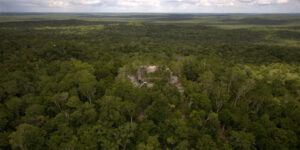MAY 21, 2023

A view of a Maya temple at the el Mirador archaeological site in the Peten jungle, Guatemala August 24, 2009. Reuters/Daniel Leclair
- Scientists in Guatemala have discovered “the first freeway system in the world,” The Washington Post reports.
- Archaeologists have found ancient Mayans built 417 cities interconnected by 110 miles of “superhighways.”
- Historians to rethink what they know of ancient Mayan civilization.
Scientists in Guatemala have discovered “the first freeway system in the world,” The Washington Post reports.
In an interview with the Post, researchers from a joint US-Guatemalan archaeological study published in the Cambridge University Press in December said they had uncovered 417 cities dating back roughly 3,000 years, interconnected by 110 miles of “superhighways.”
This discovery is making historians rethink what they know of ancient Mayan civilization. The discovery of a network of roads and cities, hydraulic systems, and agricultural infrastructure suggests that communities living in Central America were now more advanced than given credit for, the Post reports.
Per the paper, these findings reflect “socio-economic organization and political power.”
The lost world dates as far as 1,000 B.C. to the pre-classic epoch of the Mayans, which had previously been considered a nomadic, hunter-gather society.
This discovery from the El Mirador jungle region in southern Guatemala is a “game changer,” Richard Hansen, lead author of the study and affiliate research professor of archaeology at the University of Idaho, told the Post.
The find is in a remote tropical jungle on the Mexico-Guatemala border. It is only accessible by helicopter to a challenging 40 miles hike through dense, Jaguar and snake-filled rainforest, said the Post.
“We now know that the Preclassic period was one of extraordinary complexity and architectural sophistication, with some of the largest buildings in world history being constructed during this time,” said Hansen.
The findings have unveiled “a whole volume of human history that we’ve never known,” he told the Post.
The team, with scientists from the US and Guatemala, has been mapping the areas in Central America since 2015 and has used lidar technology — a key archaeological laser mapping technique — to reveal the finest details, such as ancient vegetation.
It allowed the scientists to see ancient dams, reservoirs, pyramids, platforms, causeway networks, and even ball courts, per the study.
Archaeologist at San Carlos University in Guatemala City and co-author of the paper, Enrique Hernández, told the Post that after further work on this project, it could be as influential of a historical discovery as the Egyptian pyramids.
Courtesy/Source: Business Insider

































































































